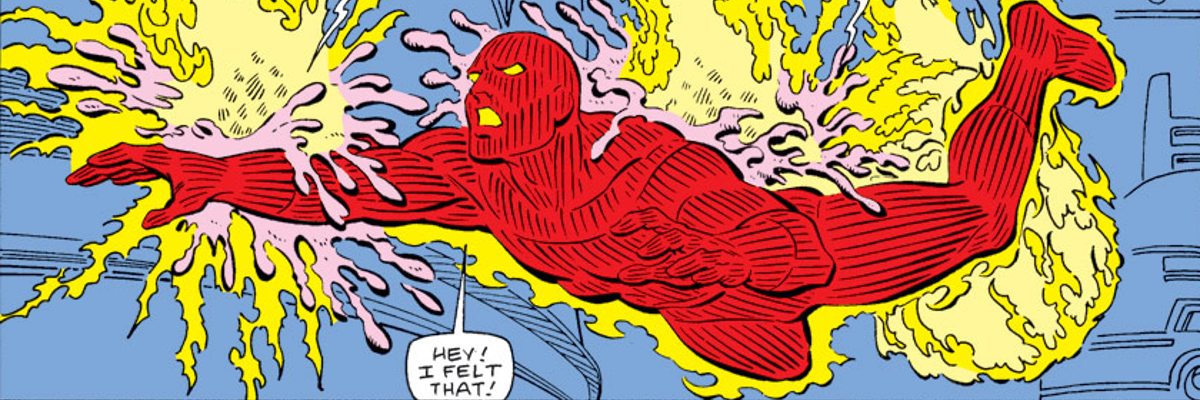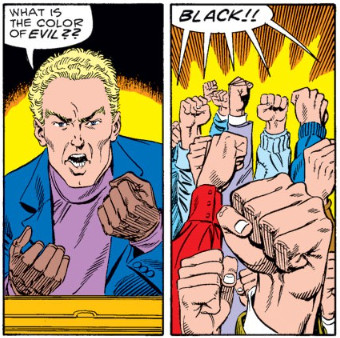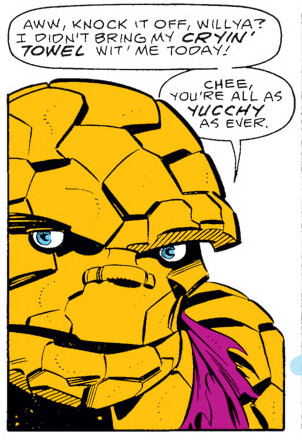Interview with Jerry Ordway
Originally published January 2017

"I've always wished for another chance at the Fantastic Four, because I felt like my pencilling was compromised by a lot of things, and I didn't have the confidence I needed to do my best."
Jerry Ordway has worked in the comics industry for over 35 years as a penciller, writer, and inker and is most well known for his work with DC, including runs "The Death of Superman" and "Crisis on Infinite Earths". The Fantastic Four was just a small part of his vast career, inking eight issues (#276-283) of John Byrne's pencils, and then pencilling two issues after Byrne left the title. He was also the cover artist for six 80s issues, and contributed to the 25th Anniversary issue. In January 2017 Jerry was kind enough to answer some questions about his time working on the book and in the industry...
Although Marvel has been a very small percentage of your work professionally, you've said that you first got into comics through reading Marvel in the '60s. However, The Fantastic Four weren't your favourites from the company, being more of an Avengers man. What kind of connection did you have to the title when you worked on it?
Well, while I am a huge Avengers fan, I did like the Fantastic Four quite a lot. By the time I was asked to ink the comic, John Byrne had been doing it for a while, and I really liked his take on the characters. I had been in comics for a few years by then, and had corresponded with John enough to know he liked my work as well. I had just become disillusioned with DC, and John asked me to ink his pencils on the Squadron Supreme 12 issue series. I agreed, and by the time I had quit DC, John was off Squadron, and asked me to ink the FF.
You inked eight issues of John Byrne's pencils, but for two of the issues you're credited as "embellisher". Does this mean that John had done the layouts and you'd also done the finished pencils as well as the inking for those issues?
I had signed on to ink, and had even inked a Doctor Doom splash, which didn't appear until a few issues into our run, when John decided to do layouts for me to finish. I felt like I wasn't quite "getting" it on those two issues, and asked for pencils. If the order had been reversed- say, I had inked 6 issues, and then he switched to layouts, I would have been fine. I just needed to get up to speed, and understand his approach, which is why those two issues I finished looked more like my work grafted onto John's figures. His layouts were detailed, but had no lighting or shadows. I was capable of filling in that stuff, but I was afraid the fans would hate it because of course, John was the selling point on the comic, not me. I was just the new kid from DC :)
I've heard you speak about how generous John Byrne was as a colleague when you worked together on Superman in the 80s, leading to your first credit as writer. Did you get to have any input in the issues you did together for The Fantastic Four?
No, I had no input. Again, it was his baby, and I didn't have anything to do except ink. Mike Carlin, my editor on FF, always laughs at what I told him when I signed on- I said I will do this, but I really just want you to send pages, and I will return them inked. I don't want any interaction, no phone calls, just let me work. This was because I was coming off working at DC, where I was kind of caught in the middle between DC editorial in New York, and Roy Thomas, who was the editor and writer of my stuff, in California. I spent way too much time on the phone between the two parties, getting direction from both, often at odds with each other :) It was a weird spot to be in, as I liked Roy a lot, but my paychecks came from New York.
Another funny thing- another reason I left DC at the time, was because I wanted a page rate increase, and they wouldn't bump me up because I was supposedly making the mid-level rate. So Carlin got me a raise at Marvel. And then of course, after I quit, DC followed up and gave me a raise, too late. $99 dollars a page for pencils. Carlin got me 100!
 Looking back at those issues today, there's elements that probably seem even more controversial in 2017 than they did in 1985, such as Reed slapping his wife and liberal use of racial slurs. How did you feel about this at the time, and do you feel it stands up today?
Looking back at those issues today, there's elements that probably seem even more controversial in 2017 than they did in 1985, such as Reed slapping his wife and liberal use of racial slurs. How did you feel about this at the time, and do you feel it stands up today?I was kind of stunned when I saw those pages come to me! I really thought John was brave to push things like he did. It was all in service to that storyline. If you want to use a character called the "Hate Monger" then you have to show that hate in a shocking way. At the time, Nazis were played out, so racial turmoil was the obvious place to take it.
John left in the middle of a story, leaving a plot to be picked up by Roger Stern, with you doing the pencils for two issues. Did you get to have any input into the remaining story?
Well, now you're jumping ahead :) I left the FF to ink/finish Crisis on Infinite Earths, somewhat under crisis circumstances. Dick Giordano couldn't ink that book in addition to his day job at DC, and George Perez wanted me. So, anyhow, we jump ahead another year or so, when I was supposed to do a follow up to Crisis, called Crisis of the Soul, with Paul Levitz writing and us co-plotting a 12 issue series. After a lot of story work with Paul and Bob Greenberger, the editor, I was all set to start at the end of 1985. Suddenly Paul left, a new editor was brought in, and I was left out of the plotting loop. Coincidentally, Byrne was having troubles with Marvel. He thought he could do Man of Steel for DC and keep doing his Marvel stuff, but things got bad, and he quit Marvel and the FF, leaving an unfinished story.
Al Gordon, who had been inking Byrne on the FF knew I had just quit my DC project, and told Carlin, who called me. So I agreed to draw the FF, with Byrne's blessing, for a few issues until my Superman title was ready to go. Weirdly enough, when the editorial coordinator at DC worried over who would draw the crossover, I suggested they ask Byrne. That became "Legends." As to the FF, I worked plot style with Roger Stern, and I think John may have given Roger some notes on what he planned for those issues. So I finished that storyline, and then was asked by Carlin to draw a chunk of the next issue, to be plotted by Jim Shooter, and dialogued by Stan Lee.
Perhaps the biggest thrill for old school fans was that you got to pencil 15 pages of the 25th Anniversary Issue, with over half of them not only inked by Joe Sinnott, but all of them dialogued by Stan Lee. What was the experience like?
 It was a surreal experience for a few reasons. One was that Mike Carlin had been having trouble with Jim Shooter over editorial style, which is the best way to phrase it. Jim Shooter had been a great presence for Marvel for the most part, but after he set sales records with Secret Wars, he started meddling too much with just about every facet of publishing, creating rules for how a comic should be written, how it should be drawn, and how it should be inked. His ideas weren't bad, but you can't dictate a single way to do things to creative people who already felt like they knew what they were doing :) So this added a lot of pressure to what I was drawing, especially since Jim had plotted the issue. I don't think anyone likes working with someone looking over your shoulder, second guessing your moves, you know? While Jim wasn't in my studio, his presence was felt :)
It was a surreal experience for a few reasons. One was that Mike Carlin had been having trouble with Jim Shooter over editorial style, which is the best way to phrase it. Jim Shooter had been a great presence for Marvel for the most part, but after he set sales records with Secret Wars, he started meddling too much with just about every facet of publishing, creating rules for how a comic should be written, how it should be drawn, and how it should be inked. His ideas weren't bad, but you can't dictate a single way to do things to creative people who already felt like they knew what they were doing :) So this added a lot of pressure to what I was drawing, especially since Jim had plotted the issue. I don't think anyone likes working with someone looking over your shoulder, second guessing your moves, you know? While Jim wasn't in my studio, his presence was felt :)
The experience as a whole, was a tough one, as Mike Carlin was fired while the book was being inked, and my pages had an awful lot of Romita-senior's art corrections on the finished inks. I don't know why Joe Sinnott didn't ink all my pages, but Bob Wiacek did the ones Sinnott turned back. I also heard, second hand, that Stan's dialogue was not spared criticism by Jim. The quote I recall, all these years later, was "Stan doesn't know the characters at all." So, look, that book is as good as it could have been, under the circumstances. I've always wished for another chance at the Fantastic Four, because I felt like my pencilling was compromised by a lot of things, and I didn't have the confidence I needed to do my best.
Were all the issues you drew for Marvel full script, or did you ever have chance to do the "Marvel Method" way of working?
Marvel rarely did anything like a full script then. 95 percent of my DC work was plot style too. That was the superior method, and artists generally preferred pacing the story, as it allowed them to make the art more lively, and avoid 5 pages of characters sitting in a diner talking :) I had the ultimate "Marvel method" experience, at the beginning of this century, working with both Stan Lee and Mike Carlin, with Michael Uslan thrown in to the mix. We all plotted my chapter of "Stan Lee Creates the DC Universe: JLA" book, via a conference call one afternoon! It was a fun experience, and very free-form, with plenty of story work for me.
Your last work on the title was a 2014 issue where you and several other artists each got chance to illustrate a "flashback" sequence. While a nice tribute to the older eras, it did also serve to highlight the difference between the old and new styles of comic book art. When Joe Sinnott was interviewed for the site he even stated that "I guess for old timers like me, they just don't look like comic books anymore." Do you feel there's still a place for the older, less computerised methods?
Oh, sure, there's no reason comics have to be digital creations. There's no one way to do anything. Plenty of people are drawing and inking digitally on tablets and computers, but plenty still work with pencil and ink on paper. Working digitally has that great weakness- it doesn't leave an original physical piece of art to sell :) I also understand what Sinnott is saying about comics not looking like comics anymore. There is a point where I look at what I do, and wonder if it's relevant anymore. I still enjoy telling stories, but it's inevitable that a 20 year old is going to bring a different approach, based on maybe years of playing video games, or reading Japanese Manga, or whatever. The world is a cluttered, busy place now. You have hundreds of TV channels, millions of web pages, computer imagery in movies that has no physical limit, like live action does, and so you have many comics that are dizzying in their detail. Add to that a computerized color palette that is infinite, and that can be overwhelming to an older fan or creator. But in among all that, you have many people doing beautiful work, for an audience of their own peers.
You've often spoken recently about how the older generation of comic book talent don't get as many opportunities in the industry these days. Do you feel this is still the case, or have things changed for the better?
Well, it's difficult to argue that ageism has disappeared, or that a lot of creators are doing better. The same thing has happened in many fields. Look, I understand that there are a lot of younger people clamoring for jobs, and people on the older spectrum have to give way. In many fields, if you hit your 50's, you hope to hold on until retirement age. With comics, it has been brutal for a lot of people I know. They worked for page rates, with no residual employee benefits. I'd hope they put money into an IRA, or pension fund, as I did, but not everyone thinks ahead. Many of them make a living by going to as many comic shows as they can, and try to sketch or sell prints. I've worked on a created owned project over the past few years, called "Semiautomagic," with the writer Alex De Campi, as a way to continue to tell stories. Commissions are good to have, but my interest is in telling a story. But clearly the immediate returns are not as good, income-wise, as working on a monthly comic from DC.
Finally, the Fantastic Four seemed to arguably lose its appeal to modern readers as comics became more "dark", and has now been cancelled altogether. Do you think that there's still a market for the title under the right direction, and would you like to be a part of it?
Well, in my opinion, if you have dark comics, you also need light comics. The Fantastic Four was kind of about family, and going on adventures, as much as it was about them fighting super powered criminals. To me the most memorable stories involved them discovering the Negative Zone, or Galactus, or Johnny Storm finding Crystal, and then the other Inhumans. The concept is still a sound one. I think, like Superman, Captain Marvel, Batman, or Captain America, if you find the core appeal of a concept, stripping away all the added stuff, you can make it work for a contemporary audience. The most successful the FF has been, in the last 20 years, has been the Mark Waid-Mike Weiringo run. The story and art complemented each other. That's still doable. I'd love to be part of it, but I'm sure there are a dozen people who could make it work.
Many thanks to Jerry Ordway for his generosity in speaking to the site. A collected paperback of his new project, "Semiautomagic", can be ordered online via Amazon.